Business Law: UK Legal System, Business Organizations, and Disputes
VerifiedAdded on 2020/11/12
|16
|5109
|478
Report
AI Summary
This report provides a comprehensive overview of business law in the UK. It begins with an introduction to the legal system, exploring different sources of law such as legislation, directives, case laws, and treaties. The report then examines the role of the government in law-making and the effectiveness of the legal system, particularly in light of recent reforms. A significant portion is dedicated to the impact of company, employment, and contract law on businesses, differentiating between legislation, regulations, and standards. The report further delves into the legal formation, management, and funding of various business organizations, including their advantages and disadvantages. Finally, it explores legal solutions for resolving business disputes, comparing and contrasting different sources of legal advice and support, and evaluating their effectiveness. The report concludes with a summary of the key findings and a list of references.
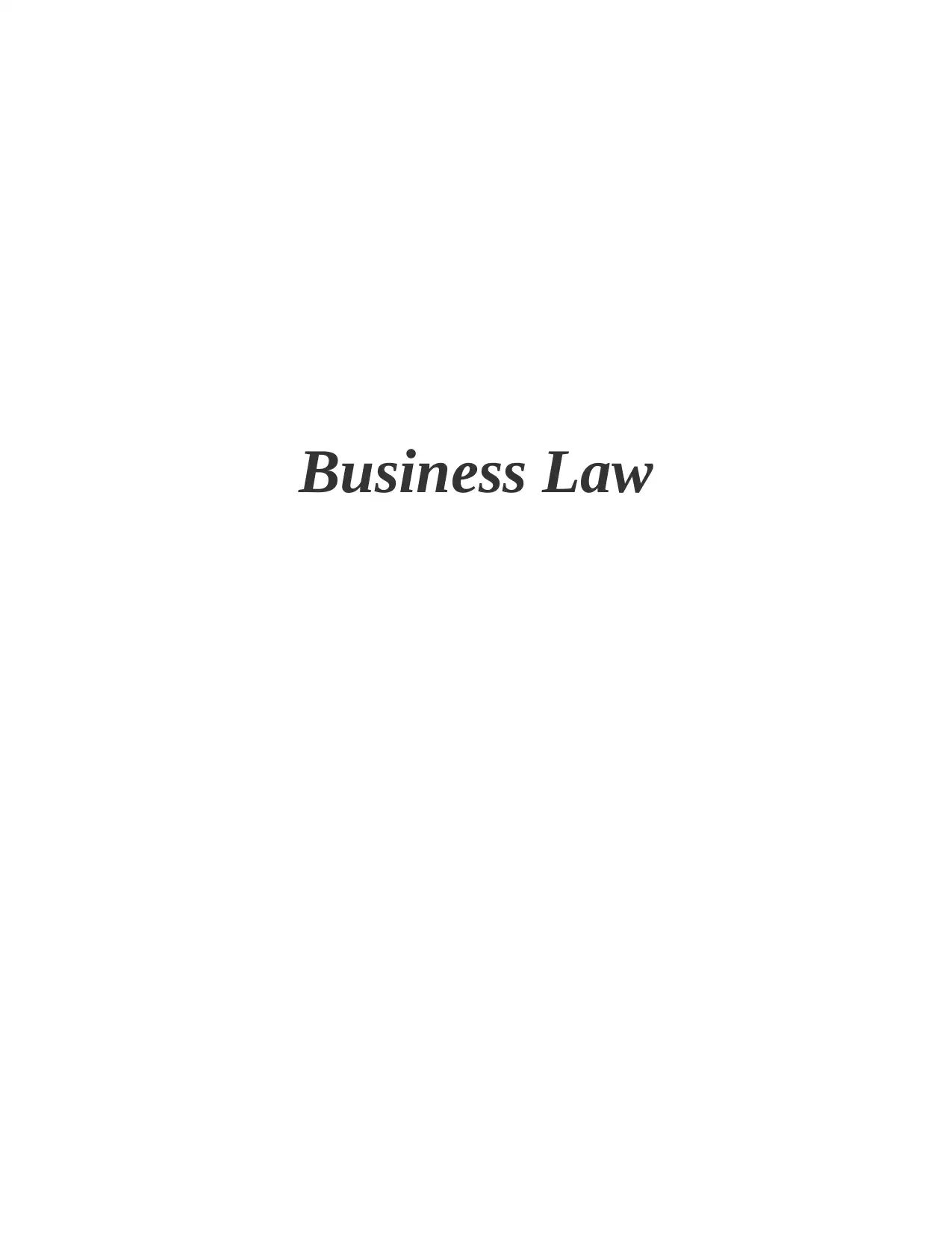
Business Law
Paraphrase This Document
Need a fresh take? Get an instant paraphrase of this document with our AI Paraphraser
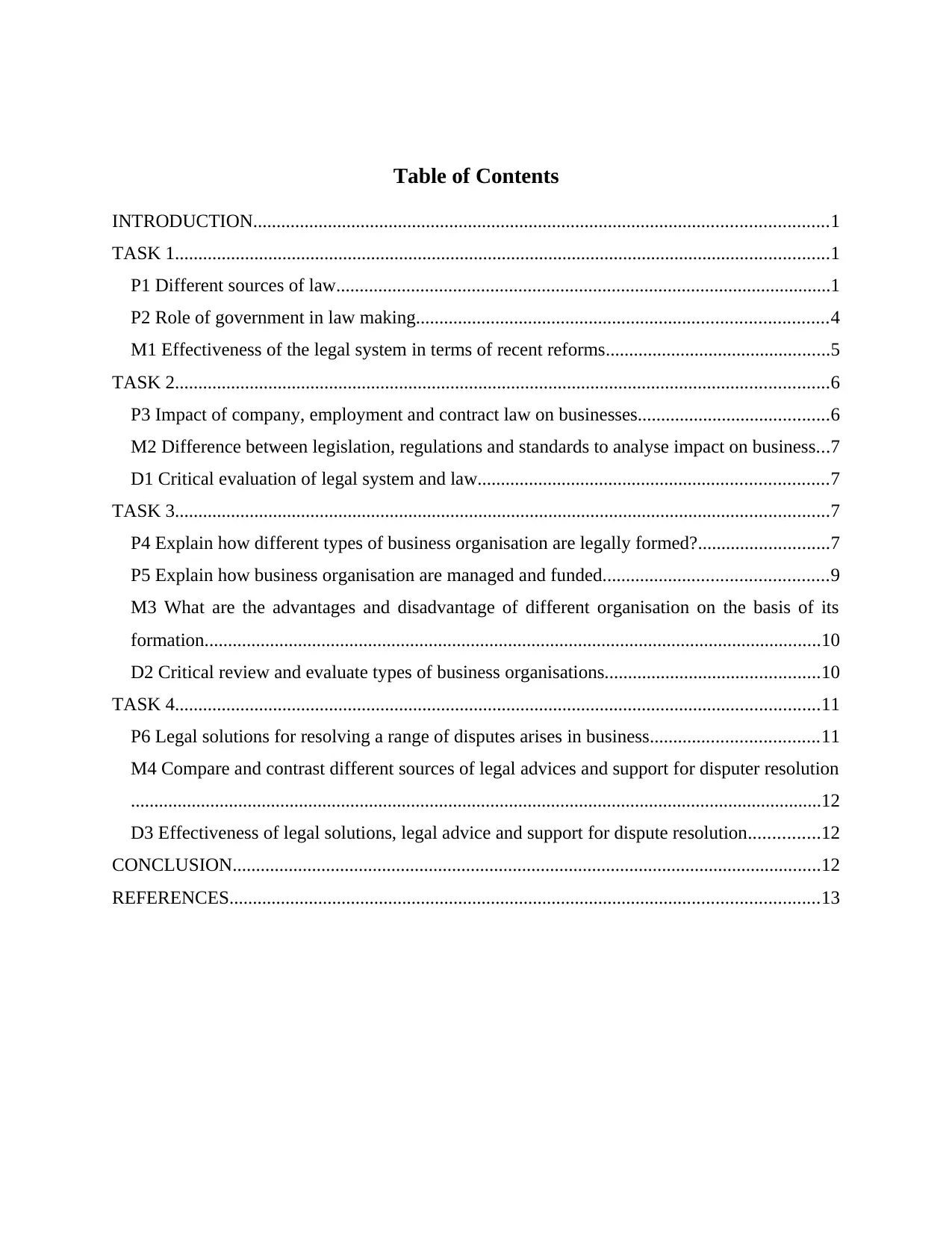
Table of Contents
INTRODUCTION...........................................................................................................................1
TASK 1............................................................................................................................................1
P1 Different sources of law..........................................................................................................1
P2 Role of government in law making........................................................................................4
M1 Effectiveness of the legal system in terms of recent reforms................................................5
TASK 2............................................................................................................................................6
P3 Impact of company, employment and contract law on businesses.........................................6
M2 Difference between legislation, regulations and standards to analyse impact on business...7
D1 Critical evaluation of legal system and law...........................................................................7
TASK 3............................................................................................................................................7
P4 Explain how different types of business organisation are legally formed?............................7
P5 Explain how business organisation are managed and funded................................................9
M3 What are the advantages and disadvantage of different organisation on the basis of its
formation....................................................................................................................................10
D2 Critical review and evaluate types of business organisations..............................................10
TASK 4..........................................................................................................................................11
P6 Legal solutions for resolving a range of disputes arises in business....................................11
M4 Compare and contrast different sources of legal advices and support for disputer resolution
....................................................................................................................................................12
D3 Effectiveness of legal solutions, legal advice and support for dispute resolution...............12
CONCLUSION..............................................................................................................................12
REFERENCES..............................................................................................................................13
INTRODUCTION...........................................................................................................................1
TASK 1............................................................................................................................................1
P1 Different sources of law..........................................................................................................1
P2 Role of government in law making........................................................................................4
M1 Effectiveness of the legal system in terms of recent reforms................................................5
TASK 2............................................................................................................................................6
P3 Impact of company, employment and contract law on businesses.........................................6
M2 Difference between legislation, regulations and standards to analyse impact on business...7
D1 Critical evaluation of legal system and law...........................................................................7
TASK 3............................................................................................................................................7
P4 Explain how different types of business organisation are legally formed?............................7
P5 Explain how business organisation are managed and funded................................................9
M3 What are the advantages and disadvantage of different organisation on the basis of its
formation....................................................................................................................................10
D2 Critical review and evaluate types of business organisations..............................................10
TASK 4..........................................................................................................................................11
P6 Legal solutions for resolving a range of disputes arises in business....................................11
M4 Compare and contrast different sources of legal advices and support for disputer resolution
....................................................................................................................................................12
D3 Effectiveness of legal solutions, legal advice and support for dispute resolution...............12
CONCLUSION..............................................................................................................................12
REFERENCES..............................................................................................................................13
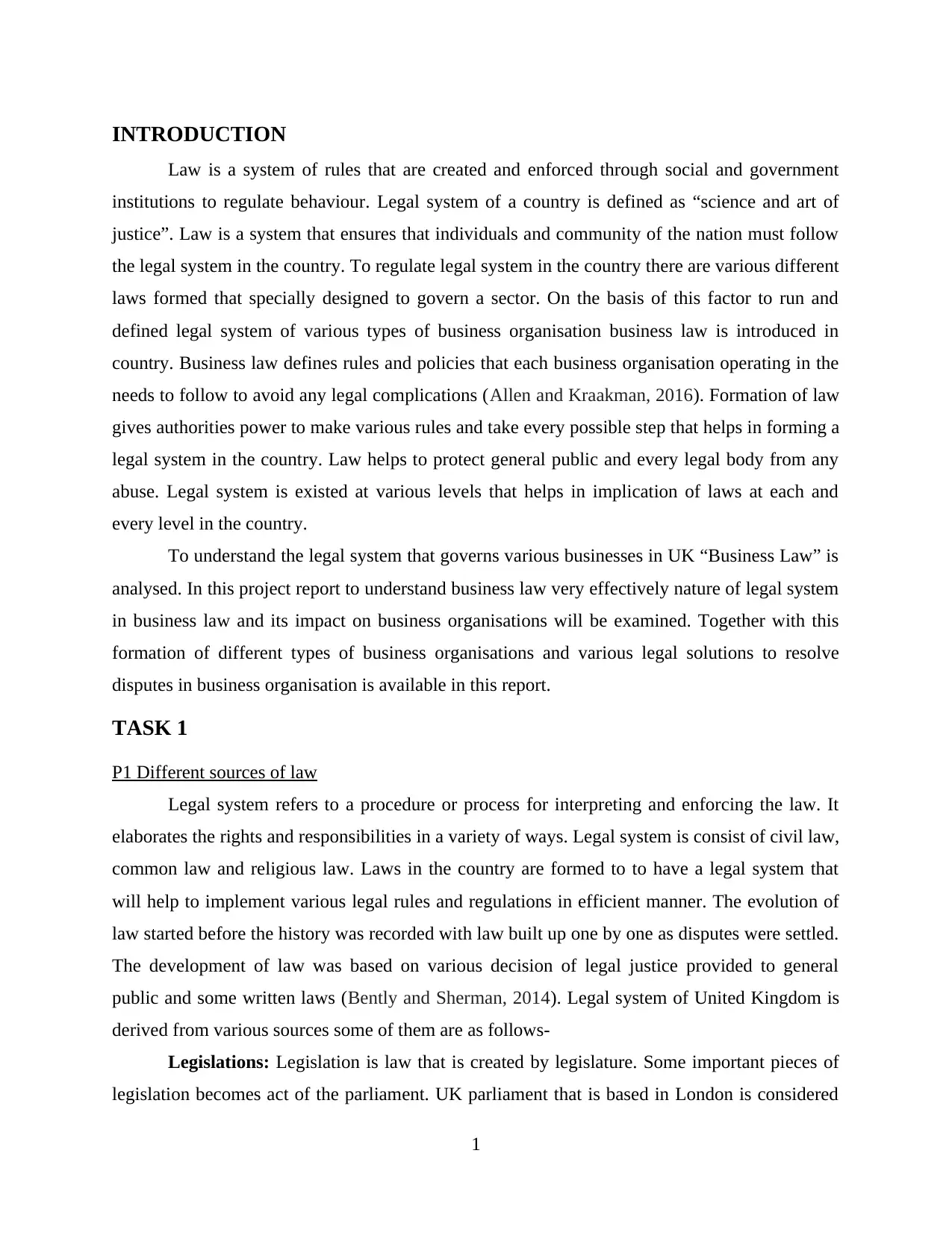
INTRODUCTION
Law is a system of rules that are created and enforced through social and government
institutions to regulate behaviour. Legal system of a country is defined as “science and art of
justice”. Law is a system that ensures that individuals and community of the nation must follow
the legal system in the country. To regulate legal system in the country there are various different
laws formed that specially designed to govern a sector. On the basis of this factor to run and
defined legal system of various types of business organisation business law is introduced in
country. Business law defines rules and policies that each business organisation operating in the
needs to follow to avoid any legal complications (Allen and Kraakman, 2016). Formation of law
gives authorities power to make various rules and take every possible step that helps in forming a
legal system in the country. Law helps to protect general public and every legal body from any
abuse. Legal system is existed at various levels that helps in implication of laws at each and
every level in the country.
To understand the legal system that governs various businesses in UK “Business Law” is
analysed. In this project report to understand business law very effectively nature of legal system
in business law and its impact on business organisations will be examined. Together with this
formation of different types of business organisations and various legal solutions to resolve
disputes in business organisation is available in this report.
TASK 1
P1 Different sources of law
Legal system refers to a procedure or process for interpreting and enforcing the law. It
elaborates the rights and responsibilities in a variety of ways. Legal system is consist of civil law,
common law and religious law. Laws in the country are formed to to have a legal system that
will help to implement various legal rules and regulations in efficient manner. The evolution of
law started before the history was recorded with law built up one by one as disputes were settled.
The development of law was based on various decision of legal justice provided to general
public and some written laws (Bently and Sherman, 2014). Legal system of United Kingdom is
derived from various sources some of them are as follows-
Legislations: Legislation is law that is created by legislature. Some important pieces of
legislation becomes act of the parliament. UK parliament that is based in London is considered
1
Law is a system of rules that are created and enforced through social and government
institutions to regulate behaviour. Legal system of a country is defined as “science and art of
justice”. Law is a system that ensures that individuals and community of the nation must follow
the legal system in the country. To regulate legal system in the country there are various different
laws formed that specially designed to govern a sector. On the basis of this factor to run and
defined legal system of various types of business organisation business law is introduced in
country. Business law defines rules and policies that each business organisation operating in the
needs to follow to avoid any legal complications (Allen and Kraakman, 2016). Formation of law
gives authorities power to make various rules and take every possible step that helps in forming a
legal system in the country. Law helps to protect general public and every legal body from any
abuse. Legal system is existed at various levels that helps in implication of laws at each and
every level in the country.
To understand the legal system that governs various businesses in UK “Business Law” is
analysed. In this project report to understand business law very effectively nature of legal system
in business law and its impact on business organisations will be examined. Together with this
formation of different types of business organisations and various legal solutions to resolve
disputes in business organisation is available in this report.
TASK 1
P1 Different sources of law
Legal system refers to a procedure or process for interpreting and enforcing the law. It
elaborates the rights and responsibilities in a variety of ways. Legal system is consist of civil law,
common law and religious law. Laws in the country are formed to to have a legal system that
will help to implement various legal rules and regulations in efficient manner. The evolution of
law started before the history was recorded with law built up one by one as disputes were settled.
The development of law was based on various decision of legal justice provided to general
public and some written laws (Bently and Sherman, 2014). Legal system of United Kingdom is
derived from various sources some of them are as follows-
Legislations: Legislation is law that is created by legislature. Some important pieces of
legislation becomes act of the parliament. UK parliament that is based in London is considered
1
⊘ This is a preview!⊘
Do you want full access?
Subscribe today to unlock all pages.

Trusted by 1+ million students worldwide
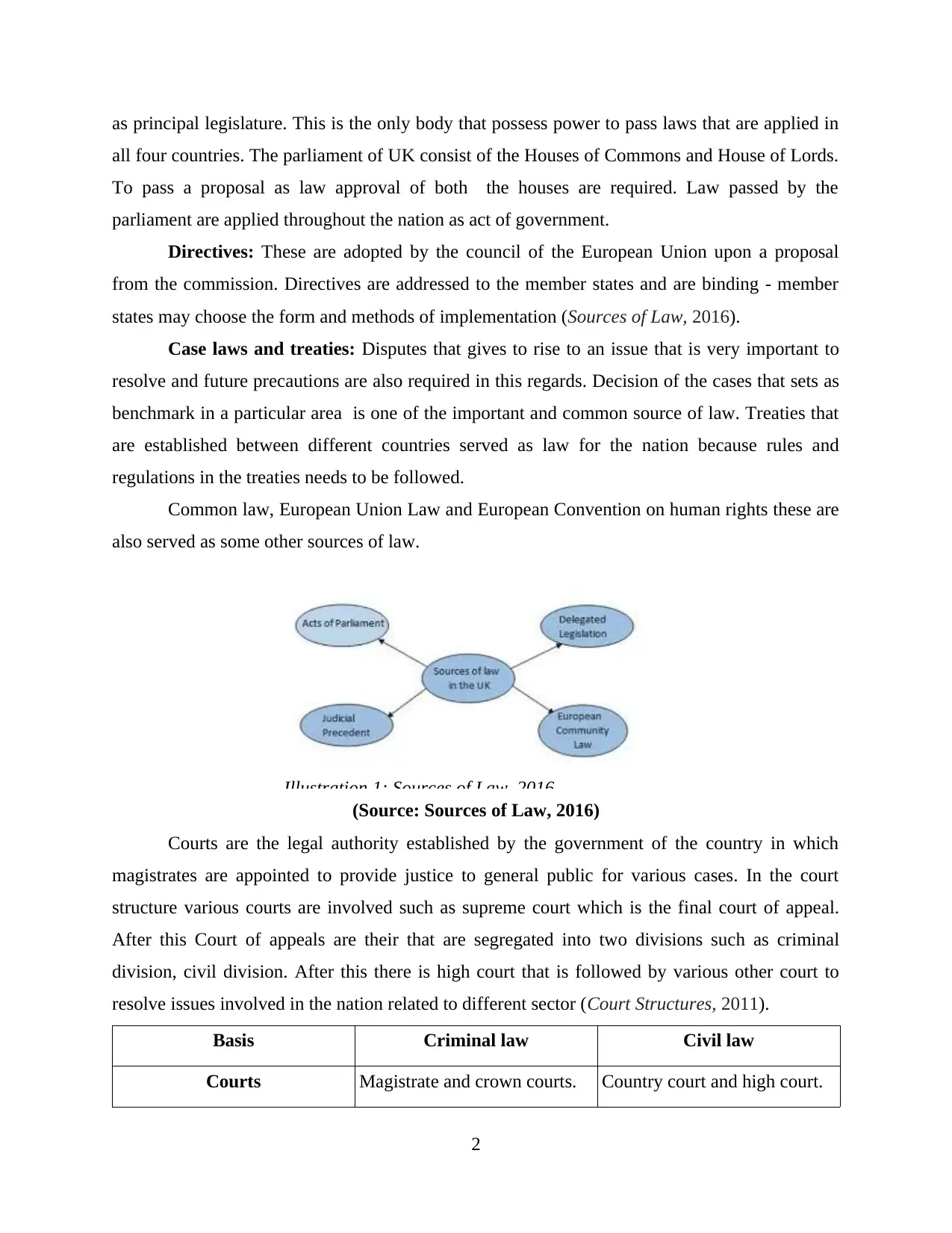
as principal legislature. This is the only body that possess power to pass laws that are applied in
all four countries. The parliament of UK consist of the Houses of Commons and House of Lords.
To pass a proposal as law approval of both the houses are required. Law passed by the
parliament are applied throughout the nation as act of government.
Directives: These are adopted by the council of the European Union upon a proposal
from the commission. Directives are addressed to the member states and are binding - member
states may choose the form and methods of implementation (Sources of Law, 2016).
Case laws and treaties: Disputes that gives to rise to an issue that is very important to
resolve and future precautions are also required in this regards. Decision of the cases that sets as
benchmark in a particular area is one of the important and common source of law. Treaties that
are established between different countries served as law for the nation because rules and
regulations in the treaties needs to be followed.
Common law, European Union Law and European Convention on human rights these are
also served as some other sources of law.
(Source: Sources of Law, 2016)
Courts are the legal authority established by the government of the country in which
magistrates are appointed to provide justice to general public for various cases. In the court
structure various courts are involved such as supreme court which is the final court of appeal.
After this Court of appeals are their that are segregated into two divisions such as criminal
division, civil division. After this there is high court that is followed by various other court to
resolve issues involved in the nation related to different sector (Court Structures, 2011).
Basis Criminal law Civil law
Courts Magistrate and crown courts. Country court and high court.
2
Illustration 1: Sources of Law, 2016
all four countries. The parliament of UK consist of the Houses of Commons and House of Lords.
To pass a proposal as law approval of both the houses are required. Law passed by the
parliament are applied throughout the nation as act of government.
Directives: These are adopted by the council of the European Union upon a proposal
from the commission. Directives are addressed to the member states and are binding - member
states may choose the form and methods of implementation (Sources of Law, 2016).
Case laws and treaties: Disputes that gives to rise to an issue that is very important to
resolve and future precautions are also required in this regards. Decision of the cases that sets as
benchmark in a particular area is one of the important and common source of law. Treaties that
are established between different countries served as law for the nation because rules and
regulations in the treaties needs to be followed.
Common law, European Union Law and European Convention on human rights these are
also served as some other sources of law.
(Source: Sources of Law, 2016)
Courts are the legal authority established by the government of the country in which
magistrates are appointed to provide justice to general public for various cases. In the court
structure various courts are involved such as supreme court which is the final court of appeal.
After this Court of appeals are their that are segregated into two divisions such as criminal
division, civil division. After this there is high court that is followed by various other court to
resolve issues involved in the nation related to different sector (Court Structures, 2011).
Basis Criminal law Civil law
Courts Magistrate and crown courts. Country court and high court.
2
Illustration 1: Sources of Law, 2016
Paraphrase This Document
Need a fresh take? Get an instant paraphrase of this document with our AI Paraphraser
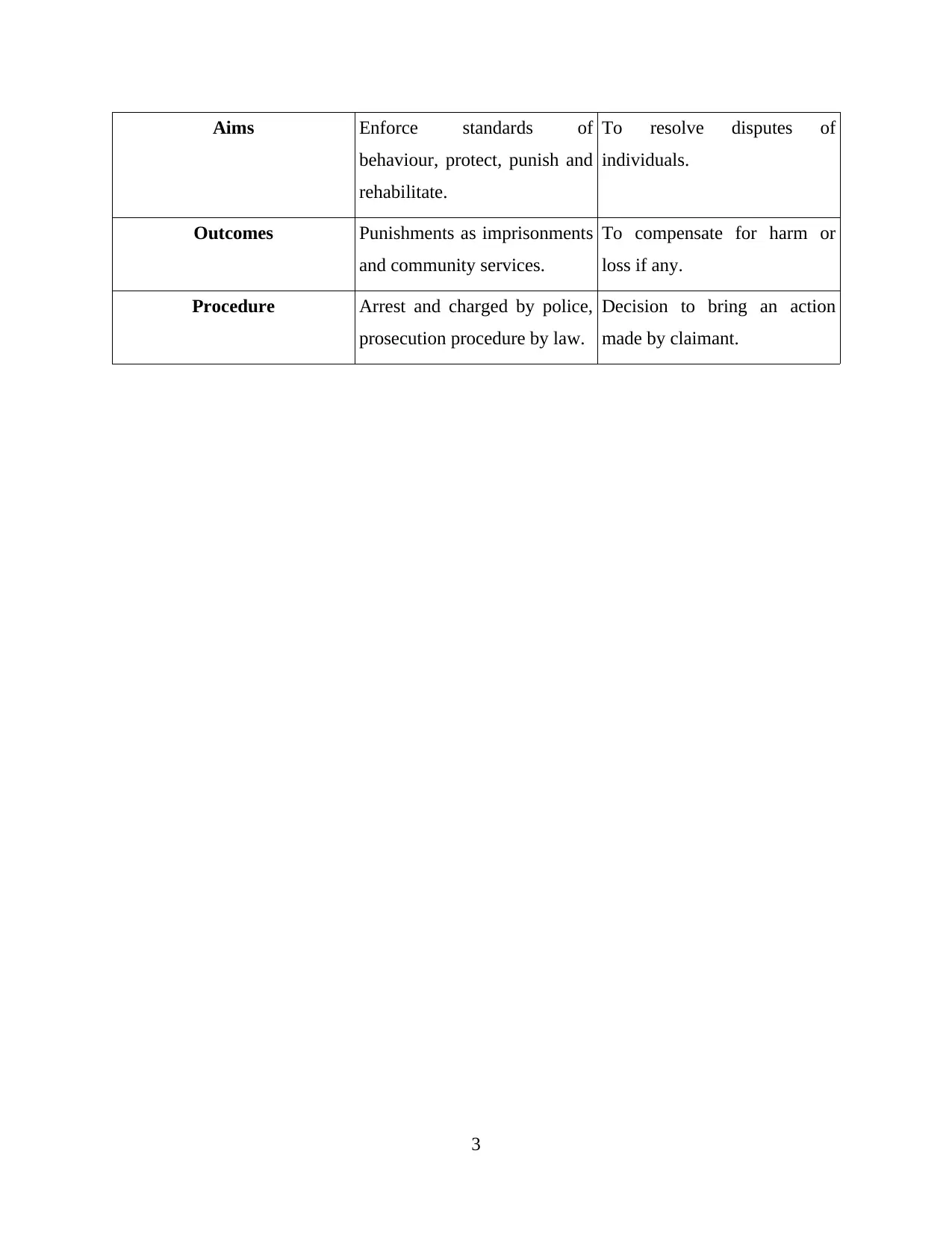
Aims Enforce standards of
behaviour, protect, punish and
rehabilitate.
To resolve disputes of
individuals.
Outcomes Punishments as imprisonments
and community services.
To compensate for harm or
loss if any.
Procedure Arrest and charged by police,
prosecution procedure by law.
Decision to bring an action
made by claimant.
3
behaviour, protect, punish and
rehabilitate.
To resolve disputes of
individuals.
Outcomes Punishments as imprisonments
and community services.
To compensate for harm or
loss if any.
Procedure Arrest and charged by police,
prosecution procedure by law.
Decision to bring an action
made by claimant.
3
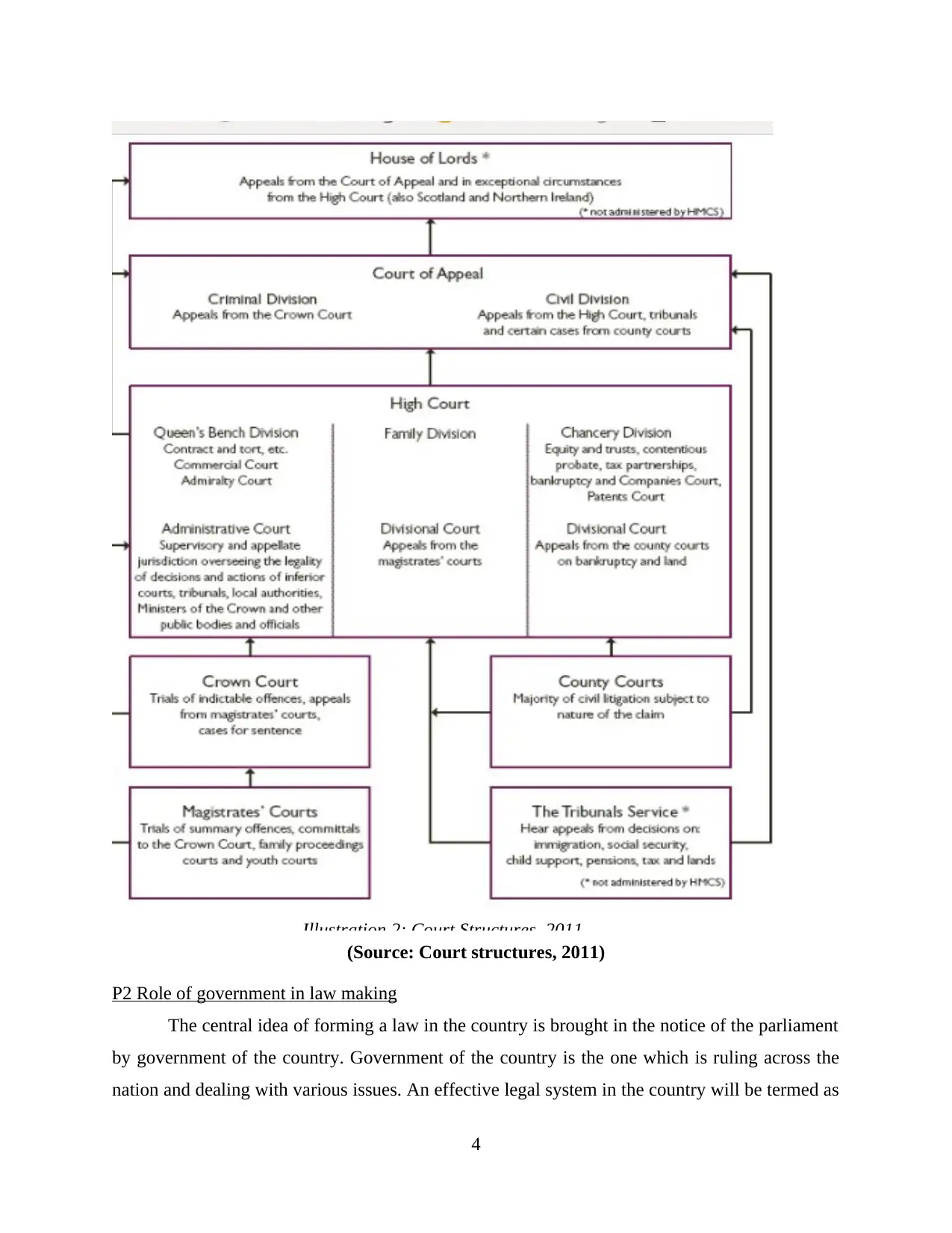
Illustration 2: Court Structures, 2011
(Source: Court structures, 2011)
P2 Role of government in law making
The central idea of forming a law in the country is brought in the notice of the parliament
by government of the country. Government of the country is the one which is ruling across the
nation and dealing with various issues. An effective legal system in the country will be termed as
4
(Source: Court structures, 2011)
P2 Role of government in law making
The central idea of forming a law in the country is brought in the notice of the parliament
by government of the country. Government of the country is the one which is ruling across the
nation and dealing with various issues. An effective legal system in the country will be termed as
4
⊘ This is a preview!⊘
Do you want full access?
Subscribe today to unlock all pages.

Trusted by 1+ million students worldwide
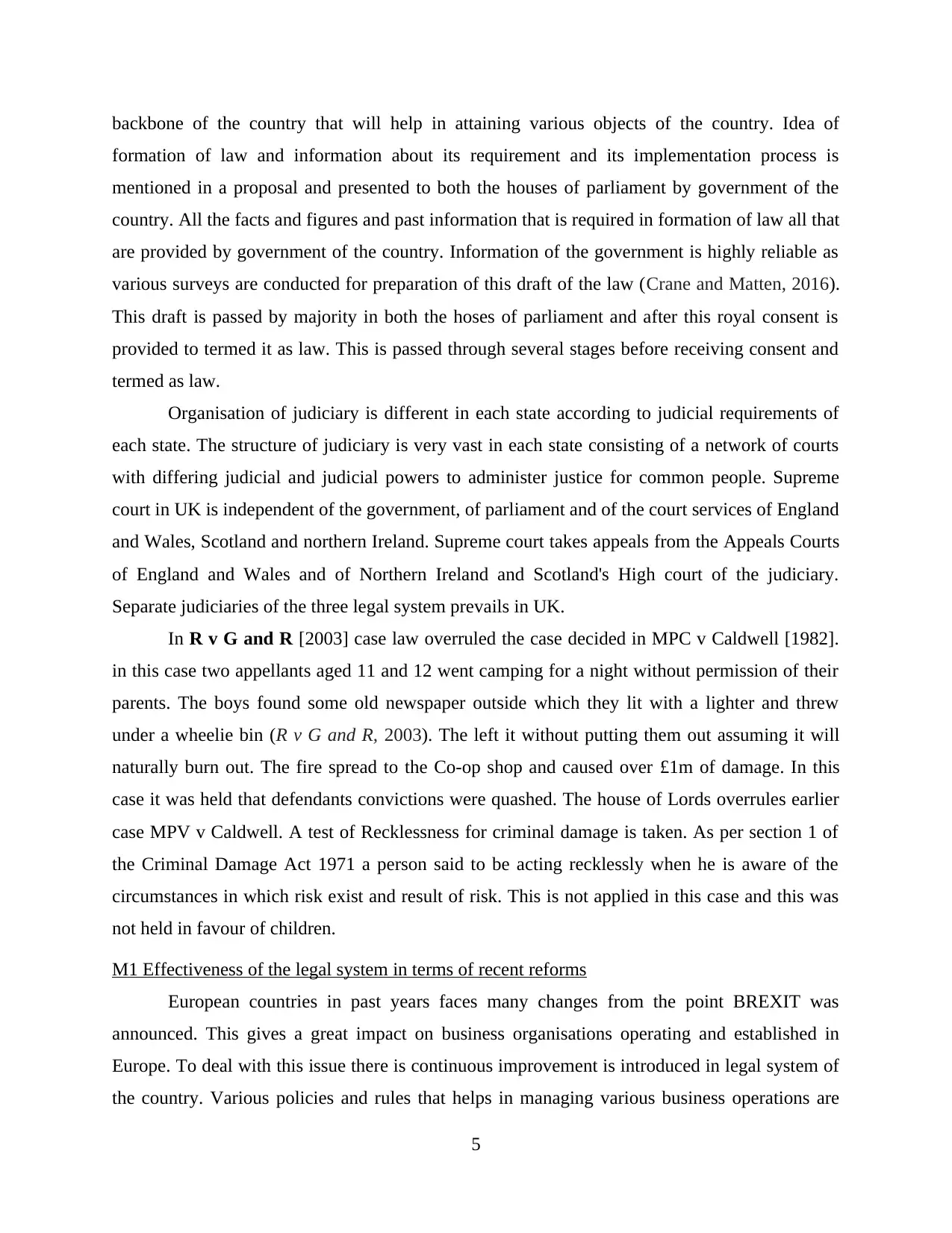
backbone of the country that will help in attaining various objects of the country. Idea of
formation of law and information about its requirement and its implementation process is
mentioned in a proposal and presented to both the houses of parliament by government of the
country. All the facts and figures and past information that is required in formation of law all that
are provided by government of the country. Information of the government is highly reliable as
various surveys are conducted for preparation of this draft of the law (Crane and Matten, 2016).
This draft is passed by majority in both the hoses of parliament and after this royal consent is
provided to termed it as law. This is passed through several stages before receiving consent and
termed as law.
Organisation of judiciary is different in each state according to judicial requirements of
each state. The structure of judiciary is very vast in each state consisting of a network of courts
with differing judicial and judicial powers to administer justice for common people. Supreme
court in UK is independent of the government, of parliament and of the court services of England
and Wales, Scotland and northern Ireland. Supreme court takes appeals from the Appeals Courts
of England and Wales and of Northern Ireland and Scotland's High court of the judiciary.
Separate judiciaries of the three legal system prevails in UK.
In R v G and R [2003] case law overruled the case decided in MPC v Caldwell [1982].
in this case two appellants aged 11 and 12 went camping for a night without permission of their
parents. The boys found some old newspaper outside which they lit with a lighter and threw
under a wheelie bin (R v G and R, 2003). The left it without putting them out assuming it will
naturally burn out. The fire spread to the Co-op shop and caused over £1m of damage. In this
case it was held that defendants convictions were quashed. The house of Lords overrules earlier
case MPV v Caldwell. A test of Recklessness for criminal damage is taken. As per section 1 of
the Criminal Damage Act 1971 a person said to be acting recklessly when he is aware of the
circumstances in which risk exist and result of risk. This is not applied in this case and this was
not held in favour of children.
M1 Effectiveness of the legal system in terms of recent reforms
European countries in past years faces many changes from the point BREXIT was
announced. This gives a great impact on business organisations operating and established in
Europe. To deal with this issue there is continuous improvement is introduced in legal system of
the country. Various policies and rules that helps in managing various business operations are
5
formation of law and information about its requirement and its implementation process is
mentioned in a proposal and presented to both the houses of parliament by government of the
country. All the facts and figures and past information that is required in formation of law all that
are provided by government of the country. Information of the government is highly reliable as
various surveys are conducted for preparation of this draft of the law (Crane and Matten, 2016).
This draft is passed by majority in both the hoses of parliament and after this royal consent is
provided to termed it as law. This is passed through several stages before receiving consent and
termed as law.
Organisation of judiciary is different in each state according to judicial requirements of
each state. The structure of judiciary is very vast in each state consisting of a network of courts
with differing judicial and judicial powers to administer justice for common people. Supreme
court in UK is independent of the government, of parliament and of the court services of England
and Wales, Scotland and northern Ireland. Supreme court takes appeals from the Appeals Courts
of England and Wales and of Northern Ireland and Scotland's High court of the judiciary.
Separate judiciaries of the three legal system prevails in UK.
In R v G and R [2003] case law overruled the case decided in MPC v Caldwell [1982].
in this case two appellants aged 11 and 12 went camping for a night without permission of their
parents. The boys found some old newspaper outside which they lit with a lighter and threw
under a wheelie bin (R v G and R, 2003). The left it without putting them out assuming it will
naturally burn out. The fire spread to the Co-op shop and caused over £1m of damage. In this
case it was held that defendants convictions were quashed. The house of Lords overrules earlier
case MPV v Caldwell. A test of Recklessness for criminal damage is taken. As per section 1 of
the Criminal Damage Act 1971 a person said to be acting recklessly when he is aware of the
circumstances in which risk exist and result of risk. This is not applied in this case and this was
not held in favour of children.
M1 Effectiveness of the legal system in terms of recent reforms
European countries in past years faces many changes from the point BREXIT was
announced. This gives a great impact on business organisations operating and established in
Europe. To deal with this issue there is continuous improvement is introduced in legal system of
the country. Various policies and rules that helps in managing various business operations are
5
Paraphrase This Document
Need a fresh take? Get an instant paraphrase of this document with our AI Paraphraser
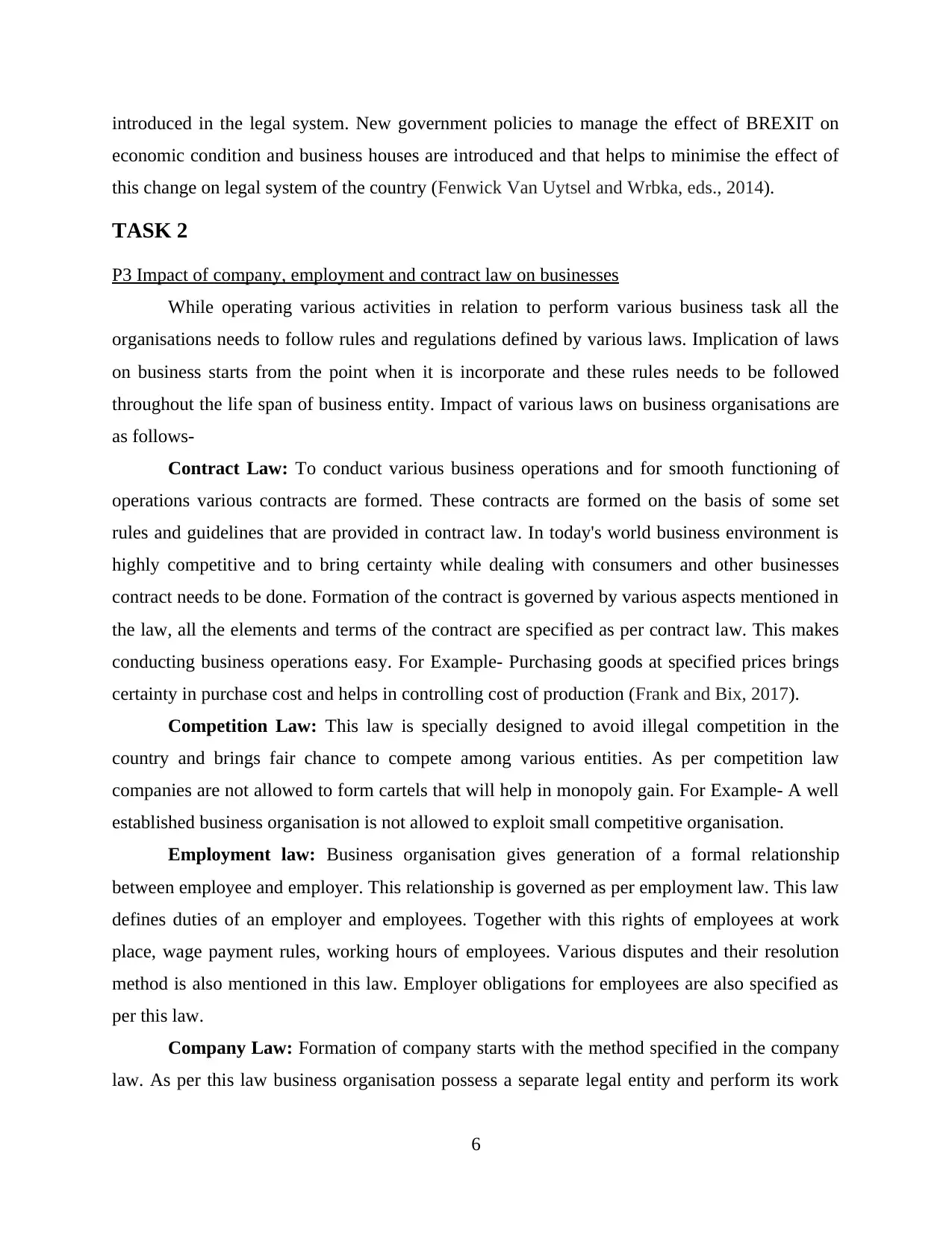
introduced in the legal system. New government policies to manage the effect of BREXIT on
economic condition and business houses are introduced and that helps to minimise the effect of
this change on legal system of the country (Fenwick Van Uytsel and Wrbka, eds., 2014).
TASK 2
P3 Impact of company, employment and contract law on businesses
While operating various activities in relation to perform various business task all the
organisations needs to follow rules and regulations defined by various laws. Implication of laws
on business starts from the point when it is incorporate and these rules needs to be followed
throughout the life span of business entity. Impact of various laws on business organisations are
as follows-
Contract Law: To conduct various business operations and for smooth functioning of
operations various contracts are formed. These contracts are formed on the basis of some set
rules and guidelines that are provided in contract law. In today's world business environment is
highly competitive and to bring certainty while dealing with consumers and other businesses
contract needs to be done. Formation of the contract is governed by various aspects mentioned in
the law, all the elements and terms of the contract are specified as per contract law. This makes
conducting business operations easy. For Example- Purchasing goods at specified prices brings
certainty in purchase cost and helps in controlling cost of production (Frank and Bix, 2017).
Competition Law: This law is specially designed to avoid illegal competition in the
country and brings fair chance to compete among various entities. As per competition law
companies are not allowed to form cartels that will help in monopoly gain. For Example- A well
established business organisation is not allowed to exploit small competitive organisation.
Employment law: Business organisation gives generation of a formal relationship
between employee and employer. This relationship is governed as per employment law. This law
defines duties of an employer and employees. Together with this rights of employees at work
place, wage payment rules, working hours of employees. Various disputes and their resolution
method is also mentioned in this law. Employer obligations for employees are also specified as
per this law.
Company Law: Formation of company starts with the method specified in the company
law. As per this law business organisation possess a separate legal entity and perform its work
6
economic condition and business houses are introduced and that helps to minimise the effect of
this change on legal system of the country (Fenwick Van Uytsel and Wrbka, eds., 2014).
TASK 2
P3 Impact of company, employment and contract law on businesses
While operating various activities in relation to perform various business task all the
organisations needs to follow rules and regulations defined by various laws. Implication of laws
on business starts from the point when it is incorporate and these rules needs to be followed
throughout the life span of business entity. Impact of various laws on business organisations are
as follows-
Contract Law: To conduct various business operations and for smooth functioning of
operations various contracts are formed. These contracts are formed on the basis of some set
rules and guidelines that are provided in contract law. In today's world business environment is
highly competitive and to bring certainty while dealing with consumers and other businesses
contract needs to be done. Formation of the contract is governed by various aspects mentioned in
the law, all the elements and terms of the contract are specified as per contract law. This makes
conducting business operations easy. For Example- Purchasing goods at specified prices brings
certainty in purchase cost and helps in controlling cost of production (Frank and Bix, 2017).
Competition Law: This law is specially designed to avoid illegal competition in the
country and brings fair chance to compete among various entities. As per competition law
companies are not allowed to form cartels that will help in monopoly gain. For Example- A well
established business organisation is not allowed to exploit small competitive organisation.
Employment law: Business organisation gives generation of a formal relationship
between employee and employer. This relationship is governed as per employment law. This law
defines duties of an employer and employees. Together with this rights of employees at work
place, wage payment rules, working hours of employees. Various disputes and their resolution
method is also mentioned in this law. Employer obligations for employees are also specified as
per this law.
Company Law: Formation of company starts with the method specified in the company
law. As per this law business organisation possess a separate legal entity and perform its work
6
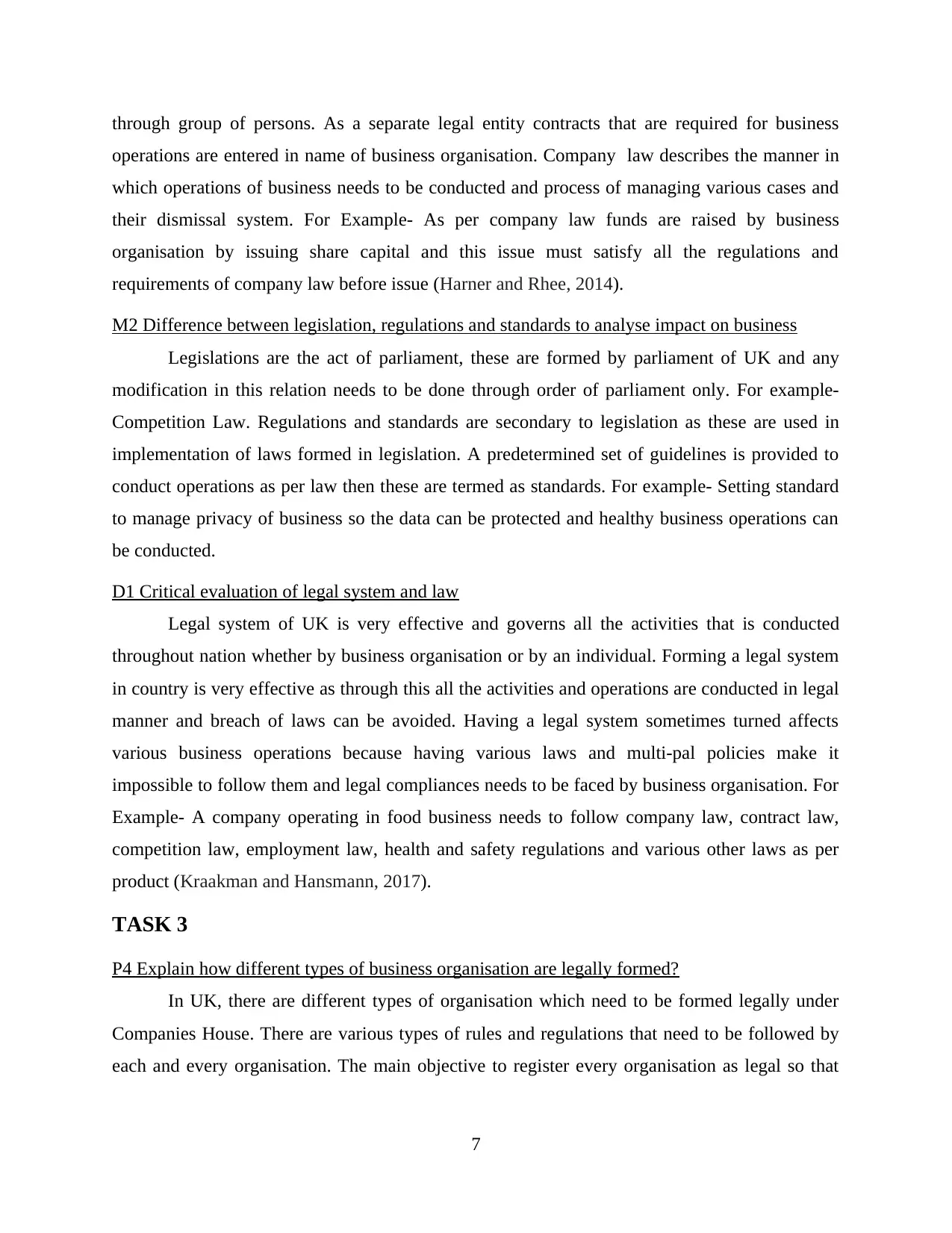
through group of persons. As a separate legal entity contracts that are required for business
operations are entered in name of business organisation. Company law describes the manner in
which operations of business needs to be conducted and process of managing various cases and
their dismissal system. For Example- As per company law funds are raised by business
organisation by issuing share capital and this issue must satisfy all the regulations and
requirements of company law before issue (Harner and Rhee, 2014).
M2 Difference between legislation, regulations and standards to analyse impact on business
Legislations are the act of parliament, these are formed by parliament of UK and any
modification in this relation needs to be done through order of parliament only. For example-
Competition Law. Regulations and standards are secondary to legislation as these are used in
implementation of laws formed in legislation. A predetermined set of guidelines is provided to
conduct operations as per law then these are termed as standards. For example- Setting standard
to manage privacy of business so the data can be protected and healthy business operations can
be conducted.
D1 Critical evaluation of legal system and law
Legal system of UK is very effective and governs all the activities that is conducted
throughout nation whether by business organisation or by an individual. Forming a legal system
in country is very effective as through this all the activities and operations are conducted in legal
manner and breach of laws can be avoided. Having a legal system sometimes turned affects
various business operations because having various laws and multi-pal policies make it
impossible to follow them and legal compliances needs to be faced by business organisation. For
Example- A company operating in food business needs to follow company law, contract law,
competition law, employment law, health and safety regulations and various other laws as per
product (Kraakman and Hansmann, 2017).
TASK 3
P4 Explain how different types of business organisation are legally formed?
In UK, there are different types of organisation which need to be formed legally under
Companies House. There are various types of rules and regulations that need to be followed by
each and every organisation. The main objective to register every organisation as legal so that
7
operations are entered in name of business organisation. Company law describes the manner in
which operations of business needs to be conducted and process of managing various cases and
their dismissal system. For Example- As per company law funds are raised by business
organisation by issuing share capital and this issue must satisfy all the regulations and
requirements of company law before issue (Harner and Rhee, 2014).
M2 Difference between legislation, regulations and standards to analyse impact on business
Legislations are the act of parliament, these are formed by parliament of UK and any
modification in this relation needs to be done through order of parliament only. For example-
Competition Law. Regulations and standards are secondary to legislation as these are used in
implementation of laws formed in legislation. A predetermined set of guidelines is provided to
conduct operations as per law then these are termed as standards. For example- Setting standard
to manage privacy of business so the data can be protected and healthy business operations can
be conducted.
D1 Critical evaluation of legal system and law
Legal system of UK is very effective and governs all the activities that is conducted
throughout nation whether by business organisation or by an individual. Forming a legal system
in country is very effective as through this all the activities and operations are conducted in legal
manner and breach of laws can be avoided. Having a legal system sometimes turned affects
various business operations because having various laws and multi-pal policies make it
impossible to follow them and legal compliances needs to be faced by business organisation. For
Example- A company operating in food business needs to follow company law, contract law,
competition law, employment law, health and safety regulations and various other laws as per
product (Kraakman and Hansmann, 2017).
TASK 3
P4 Explain how different types of business organisation are legally formed?
In UK, there are different types of organisation which need to be formed legally under
Companies House. There are various types of rules and regulations that need to be followed by
each and every organisation. The main objective to register every organisation as legal so that
7
⊘ This is a preview!⊘
Do you want full access?
Subscribe today to unlock all pages.

Trusted by 1+ million students worldwide
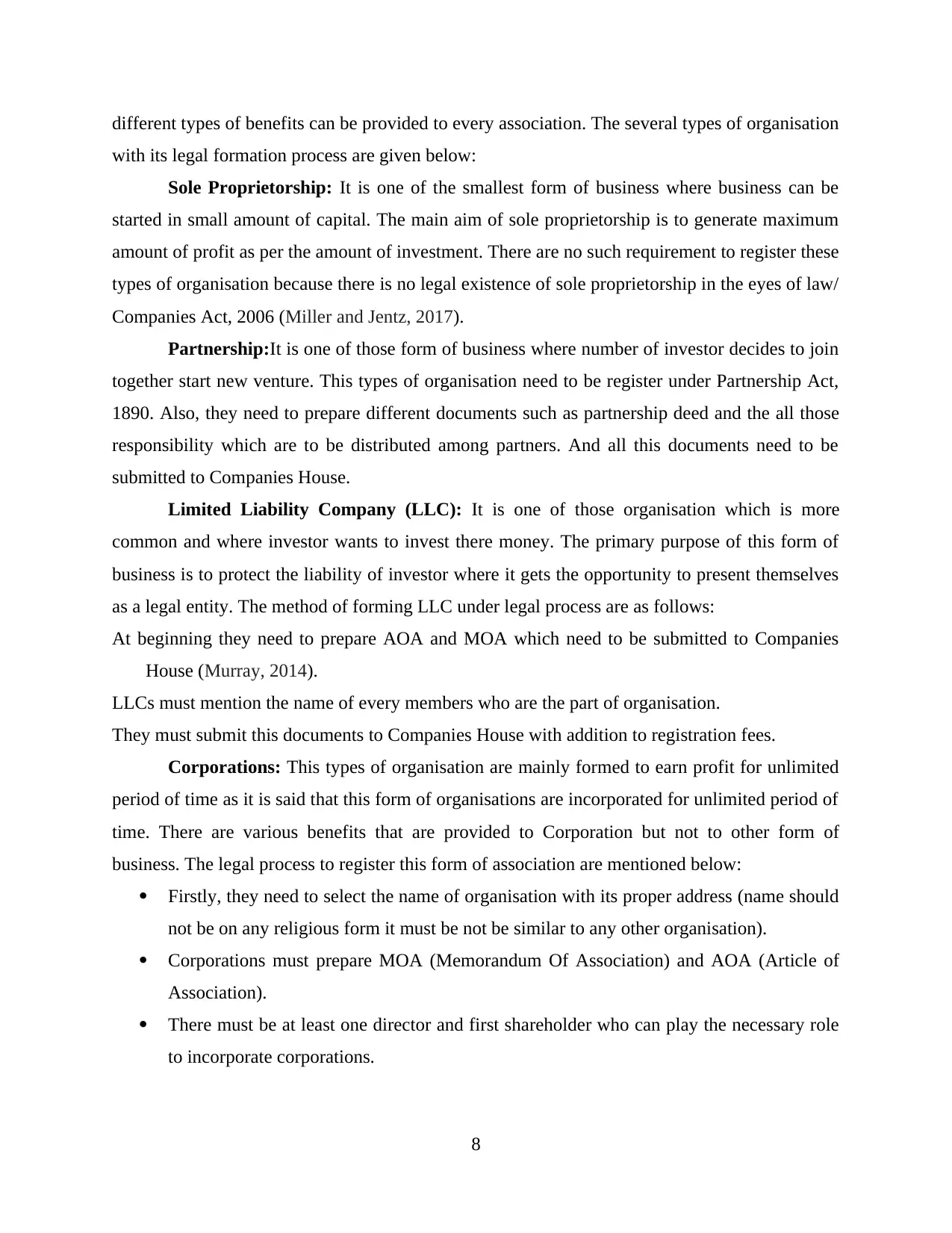
different types of benefits can be provided to every association. The several types of organisation
with its legal formation process are given below:
Sole Proprietorship: It is one of the smallest form of business where business can be
started in small amount of capital. The main aim of sole proprietorship is to generate maximum
amount of profit as per the amount of investment. There are no such requirement to register these
types of organisation because there is no legal existence of sole proprietorship in the eyes of law/
Companies Act, 2006 (Miller and Jentz, 2017).
Partnership:It is one of those form of business where number of investor decides to join
together start new venture. This types of organisation need to be register under Partnership Act,
1890. Also, they need to prepare different documents such as partnership deed and the all those
responsibility which are to be distributed among partners. And all this documents need to be
submitted to Companies House.
Limited Liability Company (LLC): It is one of those organisation which is more
common and where investor wants to invest there money. The primary purpose of this form of
business is to protect the liability of investor where it gets the opportunity to present themselves
as a legal entity. The method of forming LLC under legal process are as follows:
At beginning they need to prepare AOA and MOA which need to be submitted to Companies
House (Murray, 2014).
LLCs must mention the name of every members who are the part of organisation.
They must submit this documents to Companies House with addition to registration fees.
Corporations: This types of organisation are mainly formed to earn profit for unlimited
period of time as it is said that this form of organisations are incorporated for unlimited period of
time. There are various benefits that are provided to Corporation but not to other form of
business. The legal process to register this form of association are mentioned below:
Firstly, they need to select the name of organisation with its proper address (name should
not be on any religious form it must be not be similar to any other organisation).
Corporations must prepare MOA (Memorandum Of Association) and AOA (Article of
Association).
There must be at least one director and first shareholder who can play the necessary role
to incorporate corporations.
8
with its legal formation process are given below:
Sole Proprietorship: It is one of the smallest form of business where business can be
started in small amount of capital. The main aim of sole proprietorship is to generate maximum
amount of profit as per the amount of investment. There are no such requirement to register these
types of organisation because there is no legal existence of sole proprietorship in the eyes of law/
Companies Act, 2006 (Miller and Jentz, 2017).
Partnership:It is one of those form of business where number of investor decides to join
together start new venture. This types of organisation need to be register under Partnership Act,
1890. Also, they need to prepare different documents such as partnership deed and the all those
responsibility which are to be distributed among partners. And all this documents need to be
submitted to Companies House.
Limited Liability Company (LLC): It is one of those organisation which is more
common and where investor wants to invest there money. The primary purpose of this form of
business is to protect the liability of investor where it gets the opportunity to present themselves
as a legal entity. The method of forming LLC under legal process are as follows:
At beginning they need to prepare AOA and MOA which need to be submitted to Companies
House (Murray, 2014).
LLCs must mention the name of every members who are the part of organisation.
They must submit this documents to Companies House with addition to registration fees.
Corporations: This types of organisation are mainly formed to earn profit for unlimited
period of time as it is said that this form of organisations are incorporated for unlimited period of
time. There are various benefits that are provided to Corporation but not to other form of
business. The legal process to register this form of association are mentioned below:
Firstly, they need to select the name of organisation with its proper address (name should
not be on any religious form it must be not be similar to any other organisation).
Corporations must prepare MOA (Memorandum Of Association) and AOA (Article of
Association).
There must be at least one director and first shareholder who can play the necessary role
to incorporate corporations.
8
Paraphrase This Document
Need a fresh take? Get an instant paraphrase of this document with our AI Paraphraser
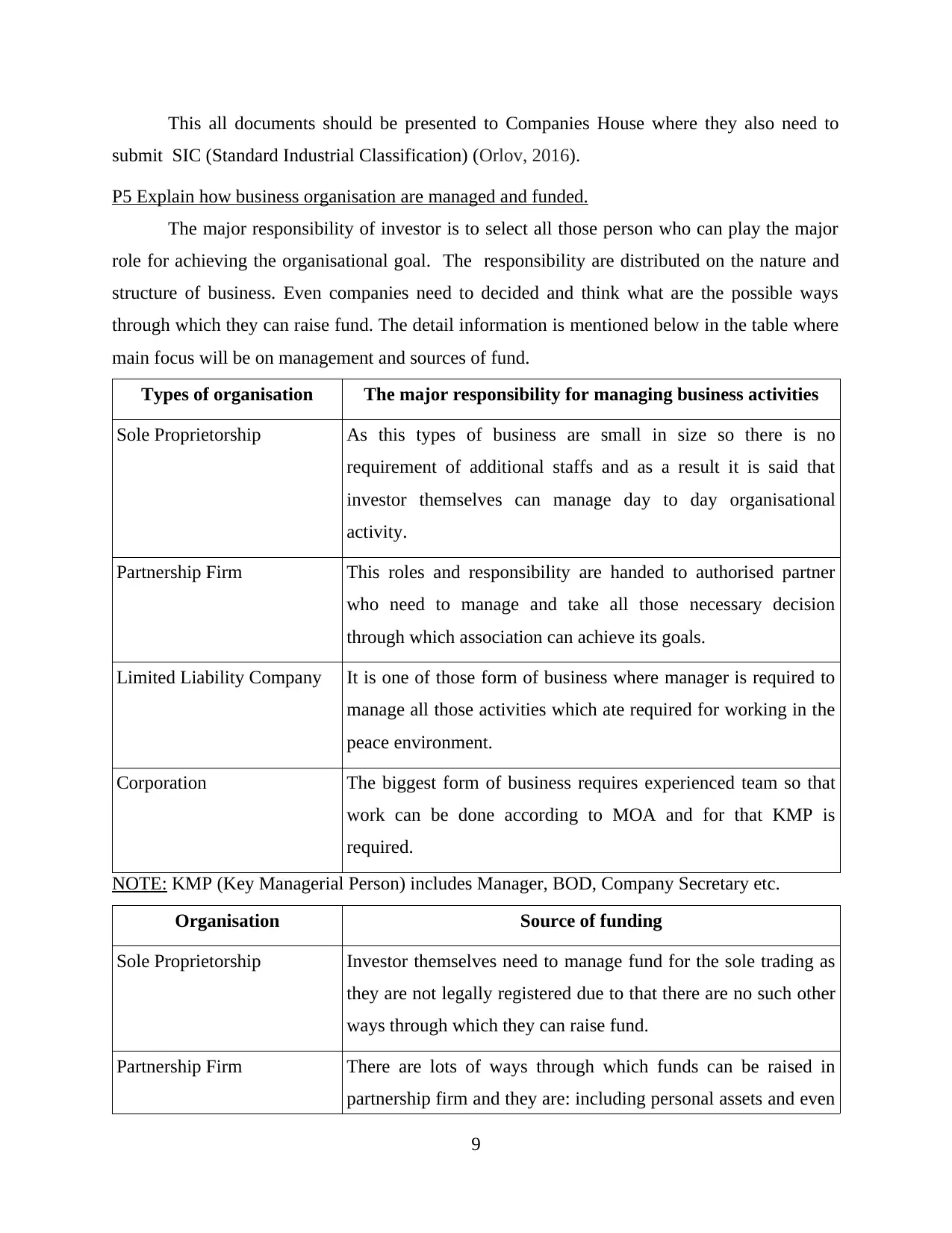
This all documents should be presented to Companies House where they also need to
submit SIC (Standard Industrial Classification) (Orlov, 2016).
P5 Explain how business organisation are managed and funded.
The major responsibility of investor is to select all those person who can play the major
role for achieving the organisational goal. The responsibility are distributed on the nature and
structure of business. Even companies need to decided and think what are the possible ways
through which they can raise fund. The detail information is mentioned below in the table where
main focus will be on management and sources of fund.
Types of organisation The major responsibility for managing business activities
Sole Proprietorship As this types of business are small in size so there is no
requirement of additional staffs and as a result it is said that
investor themselves can manage day to day organisational
activity.
Partnership Firm This roles and responsibility are handed to authorised partner
who need to manage and take all those necessary decision
through which association can achieve its goals.
Limited Liability Company It is one of those form of business where manager is required to
manage all those activities which ate required for working in the
peace environment.
Corporation The biggest form of business requires experienced team so that
work can be done according to MOA and for that KMP is
required.
NOTE: KMP (Key Managerial Person) includes Manager, BOD, Company Secretary etc.
Organisation Source of funding
Sole Proprietorship Investor themselves need to manage fund for the sole trading as
they are not legally registered due to that there are no such other
ways through which they can raise fund.
Partnership Firm There are lots of ways through which funds can be raised in
partnership firm and they are: including personal assets and even
9
submit SIC (Standard Industrial Classification) (Orlov, 2016).
P5 Explain how business organisation are managed and funded.
The major responsibility of investor is to select all those person who can play the major
role for achieving the organisational goal. The responsibility are distributed on the nature and
structure of business. Even companies need to decided and think what are the possible ways
through which they can raise fund. The detail information is mentioned below in the table where
main focus will be on management and sources of fund.
Types of organisation The major responsibility for managing business activities
Sole Proprietorship As this types of business are small in size so there is no
requirement of additional staffs and as a result it is said that
investor themselves can manage day to day organisational
activity.
Partnership Firm This roles and responsibility are handed to authorised partner
who need to manage and take all those necessary decision
through which association can achieve its goals.
Limited Liability Company It is one of those form of business where manager is required to
manage all those activities which ate required for working in the
peace environment.
Corporation The biggest form of business requires experienced team so that
work can be done according to MOA and for that KMP is
required.
NOTE: KMP (Key Managerial Person) includes Manager, BOD, Company Secretary etc.
Organisation Source of funding
Sole Proprietorship Investor themselves need to manage fund for the sole trading as
they are not legally registered due to that there are no such other
ways through which they can raise fund.
Partnership Firm There are lots of ways through which funds can be raised in
partnership firm and they are: including personal assets and even
9
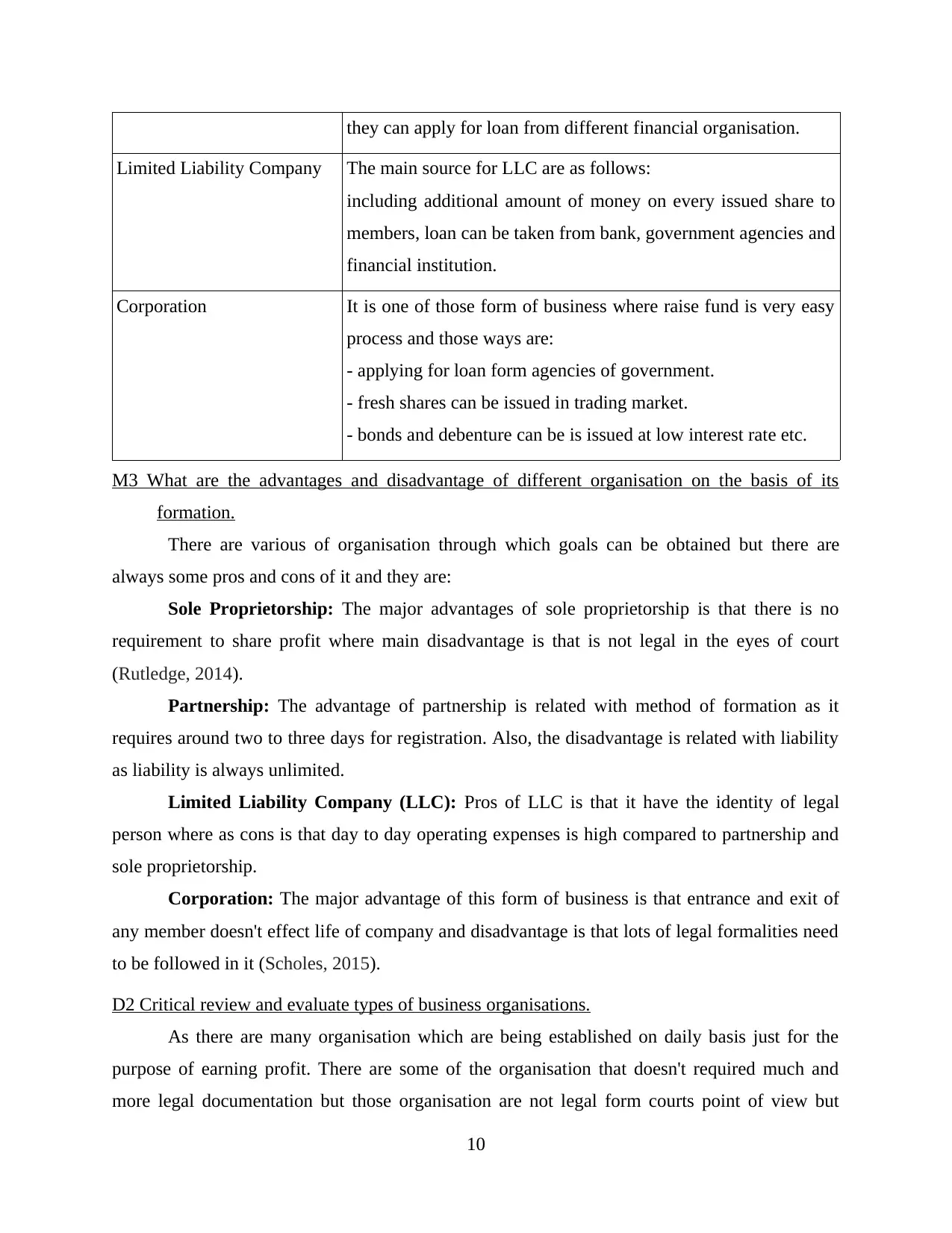
they can apply for loan from different financial organisation.
Limited Liability Company The main source for LLC are as follows:
including additional amount of money on every issued share to
members, loan can be taken from bank, government agencies and
financial institution.
Corporation It is one of those form of business where raise fund is very easy
process and those ways are:
- applying for loan form agencies of government.
- fresh shares can be issued in trading market.
- bonds and debenture can be is issued at low interest rate etc.
M3 What are the advantages and disadvantage of different organisation on the basis of its
formation.
There are various of organisation through which goals can be obtained but there are
always some pros and cons of it and they are:
Sole Proprietorship: The major advantages of sole proprietorship is that there is no
requirement to share profit where main disadvantage is that is not legal in the eyes of court
(Rutledge, 2014).
Partnership: The advantage of partnership is related with method of formation as it
requires around two to three days for registration. Also, the disadvantage is related with liability
as liability is always unlimited.
Limited Liability Company (LLC): Pros of LLC is that it have the identity of legal
person where as cons is that day to day operating expenses is high compared to partnership and
sole proprietorship.
Corporation: The major advantage of this form of business is that entrance and exit of
any member doesn't effect life of company and disadvantage is that lots of legal formalities need
to be followed in it (Scholes, 2015).
D2 Critical review and evaluate types of business organisations.
As there are many organisation which are being established on daily basis just for the
purpose of earning profit. There are some of the organisation that doesn't required much and
more legal documentation but those organisation are not legal form courts point of view but
10
Limited Liability Company The main source for LLC are as follows:
including additional amount of money on every issued share to
members, loan can be taken from bank, government agencies and
financial institution.
Corporation It is one of those form of business where raise fund is very easy
process and those ways are:
- applying for loan form agencies of government.
- fresh shares can be issued in trading market.
- bonds and debenture can be is issued at low interest rate etc.
M3 What are the advantages and disadvantage of different organisation on the basis of its
formation.
There are various of organisation through which goals can be obtained but there are
always some pros and cons of it and they are:
Sole Proprietorship: The major advantages of sole proprietorship is that there is no
requirement to share profit where main disadvantage is that is not legal in the eyes of court
(Rutledge, 2014).
Partnership: The advantage of partnership is related with method of formation as it
requires around two to three days for registration. Also, the disadvantage is related with liability
as liability is always unlimited.
Limited Liability Company (LLC): Pros of LLC is that it have the identity of legal
person where as cons is that day to day operating expenses is high compared to partnership and
sole proprietorship.
Corporation: The major advantage of this form of business is that entrance and exit of
any member doesn't effect life of company and disadvantage is that lots of legal formalities need
to be followed in it (Scholes, 2015).
D2 Critical review and evaluate types of business organisations.
As there are many organisation which are being established on daily basis just for the
purpose of earning profit. There are some of the organisation that doesn't required much and
more legal documentation but those organisation are not legal form courts point of view but
10
⊘ This is a preview!⊘
Do you want full access?
Subscribe today to unlock all pages.

Trusted by 1+ million students worldwide
1 out of 16
Related Documents
Your All-in-One AI-Powered Toolkit for Academic Success.
+13062052269
info@desklib.com
Available 24*7 on WhatsApp / Email
![[object Object]](/_next/static/media/star-bottom.7253800d.svg)
Unlock your academic potential
Copyright © 2020–2025 A2Z Services. All Rights Reserved. Developed and managed by ZUCOL.





